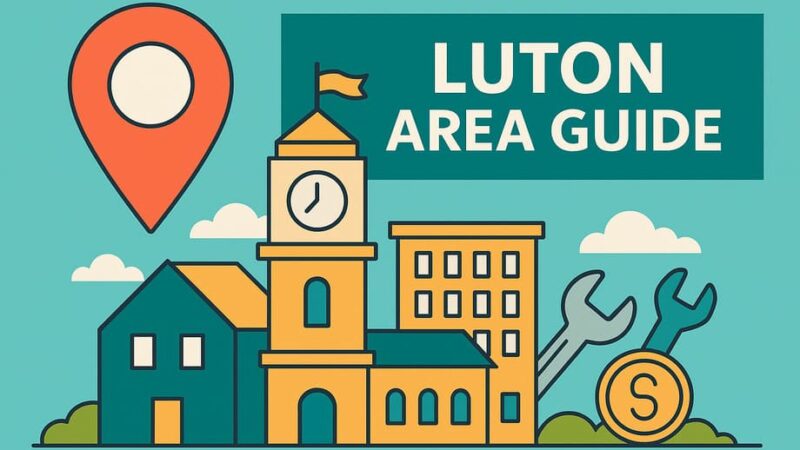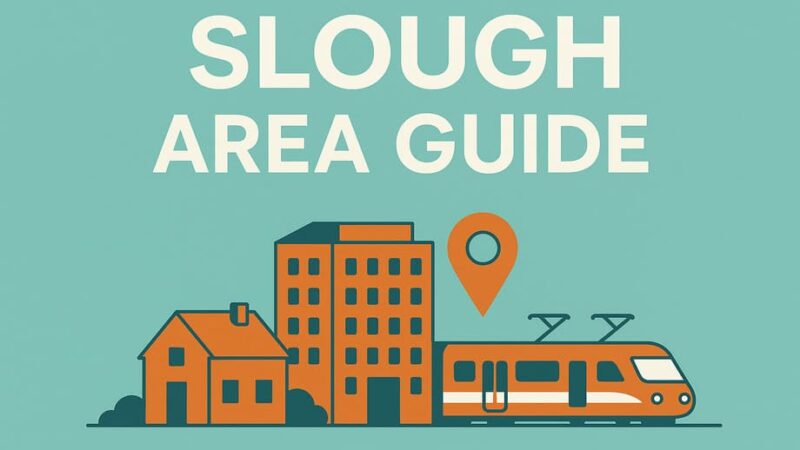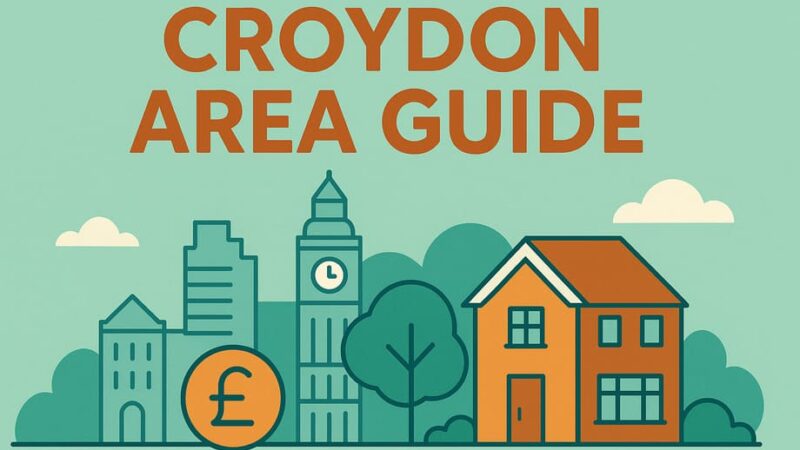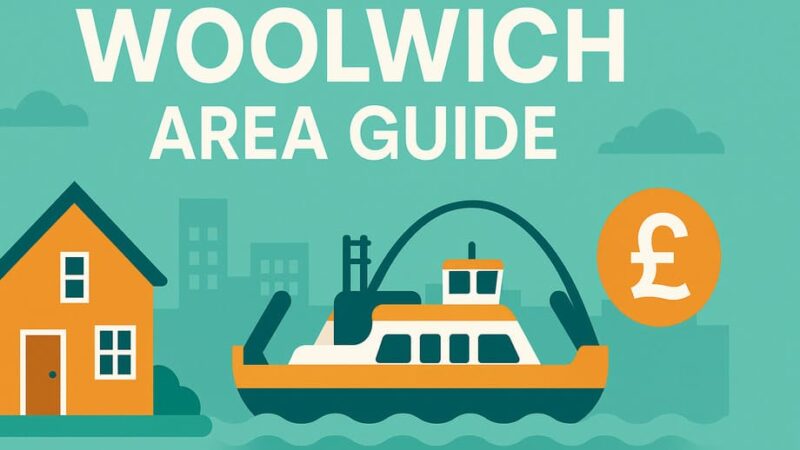Living in Ilford – Complete Guide for Renters & Buyers

Ilford has quietly become one of East London’s most compelling residential areas. Located in the London Borough of Redbridge, just over nine miles from Central London, this vibrant multicultural hub offers an unbeatable combination of affordability, excellent transport links, and rich cultural diversity. But with rapid changes brought by the Elizabeth Line and ongoing regeneration, is Ilford the right choice for your next home?
This comprehensive guide examines everything you need to know about living in Ilford in 2025, from housing costs and transport connections to schools, employment, and cultural life. Whether you’re a first-time buyer, growing family, or London commuter seeking better value, we’ll help you understand what makes Ilford tick.
Overview of Ilford
East London Appeal
Ilford sits strategically in East London, within the historic county of Essex and now part of Greater London. Just over nine miles from Central London, Ilford lies along the Great Eastern Main Line and is well-connected by road and rail. This positioning gives residents the best of both worlds: genuine London living with more space, better value, and a strong sense of community.
The Ilford advantage lies in its authentic character. Unlike some areas that have lost their identity through gentrification, Ilford has maintained its multicultural heart while steadily improving its infrastructure and amenities. The area appeals to a wide range of residents from young professionals and growing families to retirees thanks to its excellent schools, green spaces, and mix of housing options.
Cultural diversity defines modern Ilford. The area serves as home to established communities from South Asia, Africa, Eastern Europe, and the Caribbean, creating a genuinely international atmosphere. This diversity is most visible along Ilford Lane, known for its South Asian fashion boutiques, jewellers, and international supermarkets, making it a popular destination for shopping.
Regeneration momentum continues to transform the area. With direct transport links to Central London and beyond, Ilford is a popular choice for commuters who want city convenience without central London prices. The council’s regeneration strategy includes creating 6,000 new homes and 3,000 jobs for Ilford by 2030, signaling significant ongoing investment in the area’s future.
Geographic benefits include excellent connectivity to major motorways and the A12, A406 road links. It’s also easy to travel to other major towns and cities in the UK thanks to the major motorways that connect to Ilford. Cycle lanes and routes also abound, making local travel convenient and sustainable.
The area successfully balances urban convenience with suburban comfort, offering residents the amenities of London living while maintaining more affordable housing options and genuine community connections.
Housing Market
Rent Prices
Ilford’s rental market offers significant value compared to Central London, making it increasingly popular with young professionals and families seeking more space for their money.
Current rental averages (2025):
- 1-bedroom apartments: £1,100 to £1,500 per month (average £1,426 pcm according to letting agents)
- 2-bedroom flats: £1,500 to £2,000 per month
- 3-bedroom houses: £1,800 to £2,500 per month
- 4-bedroom houses: £2,200 to £3,000 per month
- 5-bedroom houses: Average of £3,444 pcm
Rental price trends show steady increases, with average asking prices in Ilford rising by 11.7% in the last year, bringing average asking prices to £1,870 pcm. This growth reflects the area’s increasing popularity, particularly following the Elizabeth Line’s arrival.
Location variations within Ilford significantly affect rental costs:
- Near stations: Premium locations within walking distance of Ilford, Seven Kings, or Gants Hill stations command higher rents
- Ilford Lane area: Popular with South Asian families, competitive pricing for quality accommodation
- Valentines area: Family-friendly location near parks, mid-range pricing
- New developments: Modern apartments near the town center fetch premium rates
Property types available include:
- Victorian terraces: Period features, often converted to flats, popular with young professionals
- 1930s semi-detached: Spacious family homes with gardens and parking
- Modern apartments: New builds with contemporary amenities, often purpose-built for rental
- Converted properties: Larger Victorian houses divided into flats and maisonettes
The rental market remains competitive but offers better value than many comparable London areas, with most properties providing parking spaces and gardens – rare luxuries in Central London.
Buying a Property
Ilford’s property market presents excellent opportunities for buyers seeking London accessibility without central London price tags.
Current average property prices (2025):
- Overall average: £498,516 over the last year (according to Rightmove)
- Alternative estimates: £446,219 (GetAgent), £429,194 average listing price
- Terraced properties: £530,913 average (majority of sales)
- Semi-detached houses: £609,803 average
- Flats/apartments: £269,743 to £277,656 average
- Detached houses: £425,000 average
Market performance shows healthy growth: overall, the historical sold prices in Ilford over the last year were 5% up on the previous year and 4% up on the 2022 peak of £478,201. This demonstrates a robust, recovering market with good investment potential.
Property types by price range:
- £240,611 – £300,000: Smaller flats and starter homes
- £300,000 – £500,000: Family houses and larger apartments
- £500,000 – £600,000: Larger family homes and premium apartments
- £600,000+: Large detached houses and executive properties
Market dynamics:
- Time to sell: Properties take an average of 14 weeks to sell
- Price reductions: Average asking price reductions of 1.5%
- Market activity: 384 estate agents have listed properties in the last 6 months, indicating healthy competition
Investment considerations:
- Regeneration impact: Ongoing investment in infrastructure and amenities supporting values
- Elizabeth Line effect: Improved transport links increasing desirability
- Rental demand: Strong rental market providing good buy-to-let opportunities
- Future growth: Council plans for 6,000 new homes may affect supply dynamics
First-time buyer advantages: The area offers more accessible entry points to London property ownership, with period features, parking, and garden space often included at prices that would only buy small apartments in many other London boroughs.
Transport
Elizabeth Line Impact
The Elizabeth Line has been transformative for Ilford, dramatically improving connectivity and making the area significantly more attractive to commuters and residents.
Journey times to key destinations:
- Liverpool Street: Around 15 minutes direct
- Canary Wharf: Approximately 25 minutes
- Paddington: Around 30 minutes
- Heathrow Airport: Direct connection, approximately 45 minutes
- Bond Street: Around 20 minutes for West End access
Service frequency is excellent: the Elizabeth Line operates 12 trains per hour between Paddington and Abbey Wood from Monday to Saturday 06:30 to 23:00, with plans to increase to 22 trains per hour in peak times.
Connectivity advantages:
- No changes required: Direct services to major London destinations
- Airport access: Direct trains to Heathrow for international travel
- West End access: Easy connections to shopping, theaters, and business districts
- Financial districts: Quick access to both City and Canary Wharf
- Onward connections: Easy interchange with other London transport networks
Economic impact: The Elizabeth Line has significantly improved travel times into Central London, with journeys to Liverpool Street taking around 15 minutes, compared to previous longer journeys requiring changes. This improvement has made Ilford a viable option for professionals working across London.
Future developments: Work continues to allow for more intensive services, with frequencies expected to increase further as the system matures and passenger demand grows.
Comparison with previous services: The transformation has been dramatic – journeys that previously required 45+ minutes with changes now take 15-20 minutes direct, making Ilford competitive with many Inner London areas for commute times.
Bus Links
Ilford benefits from comprehensive bus networks that complement the excellent rail connections, providing comprehensive coverage across East London and beyond.
Key bus routes include:
- Route 25: Connects to Stratford, Oxford Street, and beyond
- Route 123: Links to Wood Green via Ilford and Manor Park
- Route 145: Connects to Leytonstone and Dagenham
- Route 167: Links to Beckton and Waterloo
- Route 296: Connects to Romford and Canning Town
- Route 396: Night bus service maintaining 24-hour connectivity
Coverage advantages:
- Local connectivity: Extensive coverage within Ilford and to neighboring areas
- Shopping access: Direct routes to major shopping centers like Stratford Westfield
- Hospital connections: Links to major hospitals including King George Hospital
- Education links: Convenient access to colleges and universities across East London
- Night services: 24-hour transport options for shift workers and nightlife
Integration benefits: Bus services integrate seamlessly with rail connections, allowing residents to reach virtually any London destination efficiently. The bus network fills gaps in rail coverage and provides alternatives during engineering works.
Future improvements: As part of ongoing regeneration, bus services continue to be enhanced with new routes and improved frequencies responding to growing population and changing travel patterns.
Cost efficiency: Bus travel remains highly cost-effective, particularly with daily and weekly caps, making it an attractive option for local journeys and as part of combined rail/bus commutes.
The combination of Elizabeth Line rail services and comprehensive bus networks gives Ilford residents exceptional transport flexibility, rivaling many areas much closer to Central London.
Schools & Education
Local Primary & Secondary
Ilford offers a strong educational landscape with several outstanding schools alongside many good-rated institutions, making it attractive for families prioritizing education.
Primary education highlights:
- Outstanding schools: Include institutions with excellent Ofsted ratings and strong community reputations
- Diversity of choice: Range of community schools, faith schools, and academies
- Cultural reflection: Schools that celebrate and support the area’s multicultural population
- Academic standards: Generally good performance with many schools showing consistent improvement
Secondary education excellence: Seven Kings School stands out as the area’s educational flagship:
- Outstanding Ofsted rating: Rated Outstanding in September 2018
- All-through education: Serves ages 4-18 across primary and secondary phases
- Large scale: Approximately 2,230 students, providing extensive facilities and opportunities
- Academic excellence: Nearly 80% of all GCSE entries were awarded Grade 4 or above
- Destinations: Excellent progression rates to sixth form, higher education, and employment
- Comprehensive intake: Non-selective but achieving outstanding results across all ability levels
- Community focus: Serves a culturally diverse community with strong inclusion practices
Key strengths of Seven Kings School:
- Destinations: Excellent – very high proportions going on to education, training or work
- Disadvantaged pupils: Excellent support and outcomes
- Attendance: Excellent with very low absence rates
- Attainment: Excellent up to age 16, above average at 16-18
- Progress: Excellent student progress measured across all ability levels
Other notable secondary schools:
- Ilford County High School: Historic institution with strong academic tradition
- Various academies and comprehensives: Providing choice across different educational approaches
Educational advantages:
- Competition drives excellence: Multiple schools competing for students maintains high standards
- Cultural awareness: Schools experienced in supporting diverse populations
- Transport links: Easy access to schools across Redbridge and neighboring boroughs
- Higher education access: Proximity to London universities and colleges
Considerations:
- Admission criteria: Popular schools may have competitive entry requirements
- Catchment areas: Distance and catchment rules affect school choice
- Performance variation: While many schools excel, research individual institutions carefully
The educational offering makes Ilford particularly attractive to families, with Seven Kings School providing a pathway from primary through to 18 that rivals many selective institutions.
Jobs & Economy
Local Work vs Commuting
Ilford’s economy offers both local employment opportunities and excellent commuting options, providing residents with diverse career choices.
Local employment sectors include:
- Retail and hospitality: The Exchange Ilford shopping centre, high street shops, and numerous restaurants provide significant local employment
- Healthcare: Multiple GP practices, dental surgeries, and proximity to major hospitals create healthcare jobs
- Education: Local schools, Redbridge College, and University of East London campuses offer education sector roles
- Public services: Council services, libraries, and community organizations
- Small businesses: Numerous independent retailers, service providers, and professional services
- Logistics and warehousing: Some industrial estates provide warehouse and distribution jobs
Commuting advantages:
- Elizabeth Line access: 15-minute journeys to Liverpool Street open up City jobs
- Canary Wharf access: Direct connections to major financial employers
- West End accessibility: Easy reach to media, retail, and hospitality sectors
- Airport employment: Direct connections to Heathrow for aviation industry jobs
- Flexible options: Multiple transport modes support various commuting patterns
Salary considerations:
- Local roles: Generally reflect East London pay scales
- London weighting: Many roles include London weighting allowances
- Commuting costs: Excellent transport links but travel costs impact net income
- Cost of living balance: Lower housing costs offset commuting expenses for many residents
Professional development:
- London opportunities: Access to the full range of London’s job market
- Networking: Easy access to professional events and industry meetups
- Career progression: Flexibility to change jobs without relocating
- Training access: Proximity to London’s educational and training institutions
Business environment:
- Regeneration investment: New businesses attracted by improving infrastructure
- Local support: Business support services and networking opportunities
- Diverse customer base: Multicultural population supports various business types
- Transport connectivity: Good links support businesses serving wider areas
Future employment prospects: The council’s regeneration strategy aims to create 3,000 jobs by 2030, alongside 6,000 new homes, suggesting growing local employment opportunities alongside continued strong commuting options.
Many residents find the optimal balance involves local employment for family-friendly hours and community connections, or London commuting for career advancement and higher salaries, with the area’s transport links supporting both strategies effectively.
Culture & Lifestyle
Restaurants
Ilford’s culinary scene reflects its multicultural community, offering an exciting array of dining options that rival any area of London for diversity and authenticity.
South Asian cuisine dominance: Ilford Lane is renowned for its variety of South Asian restaurants, offering everything from street food to fine dining:
- Royal Nawaab Ilford: Luxurious banquet experience blending centuries-old recipes with modern elegance, featuring unlimited access to Indian and Pakistani cuisine from 100% Halal-certified ingredients
- Central Restaurant & Lounge: Indian gastro dining experience with traditional techniques and rich flavors
- Khaba Restaurant: Standout for Desi food and breakfast, known for Halwa Poori, Naan Paya, Keema Paratha, and traditional dishes
- Karachi Cuisine: Brings vibrant Karachi flavors with diverse menu from street food to hearty main courses, famous for Karachi biryani
- Masala Hut: Unique dining blending traditional Desi flavors with contemporary techniques, famous for innovative dishes like tandoori salmon
International dining diversity:
- Enigma Pan Asian & Grill: Elegant restaurant with Japanese, Korean, Chinese, Indonesian & Thai dishes plus premium steak and grill options
- African cuisine: Authentic home-cooked African inspired dishes
- Turkish and Mediterranean: Large halal eateries offering charcoal-grilled dishes
- Caribbean options: Authentic flavors reflecting the area’s diverse communities
Buffet experiences:
- Al Qasr Buffet Restaurant: Fantastic halal dining with extensive selection including Fresh Grilled Kebab, tikka wings, and chicken biryani
- JRC Global Buffet: Stylish casual dining bringing best of world food
- Gourmet Buffet: New generation of buffet restaurants with varied international options
Family-friendly options:
- Harvester Beehive: Family-friendly restaurant with grilled meats, unlimited salad bar, and vegetarian/vegan options
- Chain restaurants: All major UK chains represented for familiar options
- Cafés and casual dining: From Muffin Break to Costa Coffee for casual meals
The restaurant scene provides exceptional value, with authentic dishes often costing significantly less than comparable restaurants in Central London while maintaining high quality and generous portions.
Nightlife
While Ilford isn’t known for extensive nightlife compared to Central London, it offers a growing selection of venues and the area’s transport links provide easy access to London’s entertainment districts.
Local nightlife options:
- Sports bars: Champs Sports Bar & Grill provides American-style sports bar atmosphere with live sport coverage
- Traditional pubs: Several local pubs offering live music on weekends and traditional pub atmosphere
- Lounge venues: Central Restaurant & Lounge and similar venues provide more upscale evening experiences
- Cultural events: Kenneth More Theatre hosts regular performances from plays and musicals to comedy and children’s shows
- Community celebrations: Regular festivals and cultural events throughout the year
Advantages of location:
- London access: 15-20 minutes to Central London’s premier nightlife districts
- Liverpool Street area: Easy access to City bars and restaurants
- West End access: Direct Elizabeth Line connections to theater district and premium venues
- Shoreditch proximity: Quick connections to East London’s trendy bar and club scene
- Late-night transport: Elizabeth Line and night bus services support London night out returns
Cultural entertainment:
- Kenneth More Theatre: One of Ilford’s biggest attractions, hosting Shakespeare productions and children’s puppet shows
- Community centers: Regular cultural events, music performances, and celebrations
- Festivals: Annual celebrations reflecting the area’s diverse communities
- Redbridge Museum: Cultural events and exhibitions
Family-friendly entertainment:
- Valentines Park: Evening walks and outdoor activities
- Shopping centers: Evening shopping and dining at The Exchange Ilford
- Cinema options: Modern multiplex facilities
- Restaurant entertainment: Many restaurants offer evening entertainment and special events
Growing scene: As regeneration continues and the area attracts more young professionals, the local nightlife is gradually expanding with new bars and entertainment venues opening.
For residents wanting extensive nightlife, the strategy is typically enjoying local venues for casual evenings and using excellent transport links to access Central London for special occasions and weekend entertainment.
Pros & Cons
PROS:
Exceptional Transport Connections: Elizabeth Line provides 15-minute direct services to Liverpool Street, transforming commute times and making Central London highly accessible. Excellent bus networks complement rail services.
Outstanding Value for Money: Property prices and rents significantly lower than comparable areas with similar transport links. More space, gardens, and parking available at prices that buy only small apartments in many London areas.
Rich Cultural Diversity: Genuine multicultural community with established populations from South Asia, Africa, Caribbean, and Eastern Europe. This creates authentic international food scene, cultural events, and inclusive atmosphere.
Strong Educational Options: Seven Kings School rated Outstanding by Ofsted with excellent progression rates. Range of good primary and secondary schools serving diverse community effectively.
Comprehensive Amenities: The Exchange Ilford shopping center, excellent restaurants, parks like Valentines Park, and growing cultural facilities including Kenneth More Theatre and Redbridge Museum.
Regeneration Momentum: Council investment targeting 6,000 new homes and 3,000 jobs by 2030. Ongoing improvements to infrastructure and amenities suggest continued area enhancement.
London Access Without London Costs: Genuine London Borough status with full transport integration, but housing and living costs significantly below central areas.
CONS:
Limited Nightlife Scene: Local entertainment options remain limited compared to Central London, requiring travel for extensive nightlife and premium cultural venues.
Perception Challenges: Still working to overcome outdated perceptions as area undergoes transformation. Some may prefer more established or prestigious addresses.
Rapid Change Pressures: Rising rents and property prices as area improves may price out existing communities. Gentrification concerns as popularity increases.
Competition for Good Schools: Most popular schools may have competitive admission processes. Catchment area requirements can affect housing choices.
Parking and Traffic: Increasing popularity creating parking pressures in town center. Traffic congestion during peak hours affecting some routes.
Ongoing Development: Construction and regeneration work creating temporary disruption. Some areas still showing signs of previous disinvestment.
Transport Dependency: While excellent, residents heavily dependent on rail services for London commuting. Any disruptions significantly impact connectivity.
Conclusion
Ilford in 2025 represents one of East London’s most compelling residential opportunities, offering an unbeatable combination of affordability, connectivity, and cultural richness that’s increasingly rare in modern London.
The Elizabeth Line has been transformative, making Ilford a viable option for professionals working across London while maintaining significantly lower living costs than comparable areas. With 15-minute direct services to Liverpool Street and excellent onward connections, residents enjoy genuine London access without London prices.
For families, the educational excellence of Seven Kings School and other local institutions, combined with cultural diversity and strong community feel, creates an environment where children can thrive. The area’s multiculturalism prepares young people for modern Britain while maintaining strong community connections.
Property buyers and renters find exceptional value: the same budget that might secure a small apartment in many London areas can provide family houses with gardens and parking in Ilford. The regeneration momentum suggests good investment potential while current affordability remains attractive.
The cultural richness cannot be overstated – from the authentic restaurants of Ilford Lane to community festivals and diverse educational environments, residents experience genuine international London living rather than sanitized versions found in more expensive areas.
Ilford is ideal for:
- London commuters seeking affordability without sacrificing connectivity
- Growing families prioritizing good schools and community atmosphere
- First-time buyers wanting London property ownership at achievable prices
- Those valuing diversity and authentic multicultural communities
- Professionals needing flexible access to various London employment centers
Consider alternatives if you:
- Prioritize extensive local nightlife and premium entertainment venues
- Prefer established prestige areas over emerging neighborhoods
- Want immediate perfection rather than ongoing improvement
- Dislike rapid change and development activity
- Need extensive local employment rather than London commuting options
The verdict: Ilford offers the sweet spot of London living – genuine accessibility, cultural richness, strong communities, and real value for money. The area is in transition, improving rapidly while retaining its authentic character and affordability.
For those who can see past any remaining rough edges to appreciate substantial advantages, Ilford provides an increasingly rare opportunity: London living that’s actually sustainable for normal budgets, with communities that welcome newcomers while maintaining their cultural identity.
In the context of London’s housing crisis and transport costs, Ilford represents genuine opportunity. The combination of Elizabeth Line connectivity, cultural vibrancy, educational excellence, and affordability creates compelling reasons to consider this East London gem seriously.
Whether you’re starting out, raising a family, or simply seeking better value London living, Ilford deserves careful consideration as one of the capital’s most promising residential areas.
Last Updated on August 29, 2025 by James Cartwright







